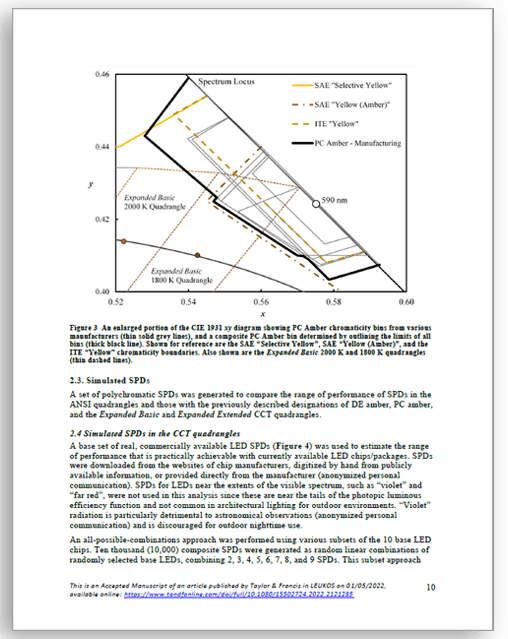This website uses cookies so that we can provide you with the best user experience possible. Cookie information is stored in your browser and performs functions such as recognising you when you return to our website and helping our team to understand which sections of the website you find most interesting and useful.

Journal Article: Specifying non-white light sources in outdoor applications to reduce light pollution
Anthropogenic, or "human-generated” outdoor light at night produces light pollution - especially LED lighting, which emits more of the blue-violet light spectrum that contributes to sky glow. To combat light pollution, which can cause a range of negative impacts to humans, plants, and animals, “amber” LEDs are being installed in lieu of "white" LEDs. However, because there is no standardized terminology or chromaticity designation that applies these outdoor “amber” or non-white light sources, the DLC has been unable to include them in the LUNA V1.0 Technical Requirements.
This journal article, co-authored by the DLC's Senior Lighting Scientist, Leora Radetsky, was originally published in Leukos, The Journal of the Illuminated Engineering Society on January 5, 2023. It proposes a specification structure for amber light sources to increase the precision of language used in the industry, and encourages lighting standards development organizations to consider creating standards . It also demonstrates that non-white light sources with chromaticity ranges outside of the ANSI C78.377-2017 quadrangles may be useful for reducing sky glow, a phenomenon that is associated with approximately $7 billion in wasted energy and nearly 66 million metric tons of CO2 emissions annually. Key takeaways from the proposal include:
- A call for the lighting industry to consider developing industry consensus definitions and standards for “amber" light sources.
- Methodology for expanding ANSI standard CCT chromaticity bins to include three new bins: 1800K, 2000K, and PC Amber.
- Discussion of why CCT alone is not an adequate representation of the spectral composition of light, and the wide range of potential impacts to sky glow.
- A call for additional research to address the fact that amber light sources are not a panacea: these wavelengths may still have negative consequences for some organisms depending on specific spectrum and exposure.
- An Excel calculator tool based on the IES TM-30 calculator, developed by the authors for non-white light specification. This tool determines the bin that the product under consideration falls into and is available to download here.
© 2023 DesignLights Consortium. The DesignLights Consortium is a project of Efficiency Forward, Inc., a non-profit 501(c)3 organization. Privacy Policy Terms of Use

